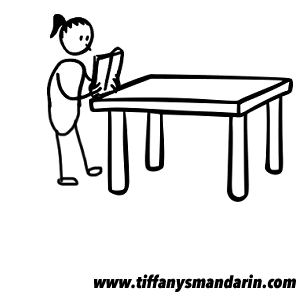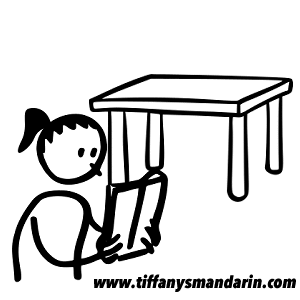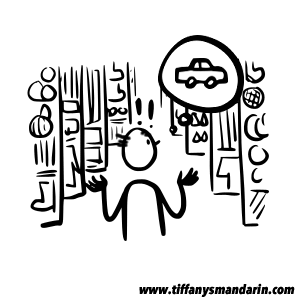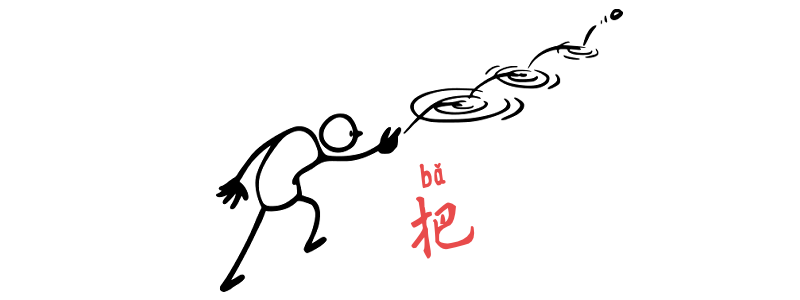Grammar Point:
There are 3 functions of 把 bǎ in Chinese. Determination, command, and doing a movement on something that makes a change to it. And since 把 bǎ cannot be translated into English, many English speakers feel awkward using it. But it is a piece of grammar that Chinese native speakers use a lot in daily conversation. So if you used to be confused about how to use it, just forget everything you have learned before. Let’s start it again with me!
Difference between with 把 and without 把
The short answer: it’s about emphasizing the object.
Unlike English, Chinese usually puts the most important information at the beginning of a sentence. That’s why time and people often come first.
But what if you want to highlight a particular object. Something really important? Simple: move it to the front! Doing that shifts it from just “an object” to the object — the focus of the sentence.
The verb stays at the end, which makes it easy to add extra details or explanations afterward. These extra parts are what we call complements in Chinese grammar.
When Do We Use It
- Determination (usually with “I” as the subject): This is used to express one’s determination or resolve to do something.
- Command (usually with “you” as the subject): This is used to give a command, requirement, or instruction. It can also be used when talking about moving something or decorating.
- Action that produces a change in something (with a known object): This is the most common sentence pattern. We use this pattern when referring to something that has happened to ‘the known object‘.
Before We Start
- It is only used for something that both the listener and the speaker know.
- We cannot use it for feelings: love, feel, hate, like, loss, etc.
- It always needs something after the verb.
- All negation words and adverbs should be put in front of 把 bǎ.
What Can Be That ‘Something After the Verb’
There are 5 kinds of something that can go with 把 bǎ.
- Result Complements: 了 le, 完 wán, 开 kāi, 得 de, etc.
- Directional Complements: 进去 jìnqù, 出来 chūlái, 上去 shàngqù, 下去 xiàqù, etc.
- Quantity Complements: 一次 yícì, 十遍 shíbiàn, etc.
- Special Verbs: 在 zài、到 dào、給 gěi、成 chéng
- Showing Short Time: V了V, V一V, V一下
We are not going to talk about all the above at this level. I’m only listing them out so you can get an idea.
Structure
First, you need to know about 把 bǎ, which changes the order of Chinese sentences. We have learned Chinese sentence’s structure is subject + verb + object, but with this 把 bǎ, it becomes subject + 把 bǎ + object + verb + something. (That something is necessary and very important in the 把 bǎ structure.)
S + 把 bǎ + O + Verb + 在 zài/到 dào + Place
The difference between 在 and 到 is 在 focus on making the object exist somewhere, while 到 usually needs a movement action to move to somewhere.
Common verbs with 在 zài are: 放 fàng (put), 掛 guà (hang), 收 shōu (take in)

妹妹把書放在桌子上妹妹把书放在桌子上
My sister put the book on the table.
(Doing a movement ‘put” on the book that makes the book on the table.)

妹妹把書放到桌子上妹妹把书放到桌子上
My sister put the book on the table.
(Doing a movement ‘put” on the book that makes the book on the table.)
你不能把車停到公司前面你不能把车停到公司前面
You cannot park your car in front of the office.
(Command)
我應該現在把東西寄到美國嗎?我应该现在把东西寄到美国吗?
Should I send my stuff to the US now?
(Doing a movement “send” on my stuff that makes my stuff arrive in the US.)
S + 把 bǎ + O + Verb + 給/给 gěi + Target
To indicate a transfer of possession. In this usage, “把” is used before the object being transferred and the verb is placed after the object.
Common verbs in this structure are: 送 sòng (give for free), 拿 ná (take), 递 dì (hand in), 卖 mài (sell), 借 jiè (borrow/lend), 还 huán (return), 介绍 jièshào (introduce), 寄 jì (send).

爺爺把新買的玩具送給了妹妹爷爷把新买的玩具送给了妹妹
Grandpa gave a new toy to my sister.
(Determination)
我不想把禮物拿給他我不想把礼物拿给他
I don’t want to give him a gift.
(Determination)
我真的不該把錢借給朋友我真的不该把钱借给朋友
I really shouldn’t lend money to friends.
(Determination)
S + 把 bǎ + O + Verb + Result Complements
你快把藥吃完你快把药吃完
You should finish your medicine quickly.
(Command)
誰把我的信打開了谁把我的信打开了
Who opened my letter?
(Doing a movement “open” on the letter that makes the letter is opened.)
媽媽把衣服洗得非常乾淨妈妈把衣服洗得非常干净
Mom washed the clothes very clean.
(Doing a movement “wash” on clothes that make the clothes very clean.)
S + 把 bǎ + O + Verb + Directional Complements
孩子把褲子脫下來孩子把裤子脱下来
The child took off his pants.
(Doing a movement “take off” on pants that make the pants off.)
把錢全部拿出來把钱全部拿出来
Take out all the money.
(Command)
你等一下記得把垃圾拿下去你等一下记得把垃圾拿下去
Please remember to take the garbage down later.
(Command)
Common Mistakes
我把咖啡喝在咖啡店我把咖啡喝在咖啡店 ❌
I drink my coffee in a coffee shop.
(Doing a movement “drink” on the coffee that doesn’t make the coffee exist in the cafe.)
請你把一杯水拿給我请你把一杯水拿给我 ❌
Please bring me a glass of water.
(A glass of water is not what both the speaker and listener know.)
請你把那杯水拿給我请你把那杯水拿给我 ✅
Please bring me that glass of water.
(Instead of a glass of water, you should say “that” or “my” or something equivalent to “the.”)
我把他愛了我把他爱了 ❌
I loved him.
(Feelings are not ok to use 把bǎ)
哥哥把筆不放在桌上哥哥把笔不放在桌上 ❌
My brother does not put the pen on the table.
(All the negation words and adverbs should be put in front of 把 bǎ.)
Practice
- 把 bǎ Part 2 (HSK 4)
- 把 bǎ Part 3 (HSK 5)
- 把 bǎ Part 4 (HSK 6)
- Advanced 把 bǎ Part 5 (HSK 7-9)


